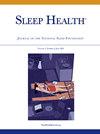Work ability and health-related productivity loss by chronotype: Results from population-based panel study
IF 3.4
2区 医学
Q2 CLINICAL NEUROLOGY
引用次数: 0
Abstract
Objectives
This study aimed to explore the relationship between chronotype and two key occupational health outcomes—work ability and health-related productivity loss—in the general working population of Korea. The research further sought to identify subgroup variations by demographic and occupational factors.
Methods
Data were derived from the Korean Work, Sleep, and Health Study (KWSHS), a nationwide panel study conducted between 2022 and 2024. Chronotype was assessed using the reduced Morningness-Eveningness Questionnaire (rMEQ), categorizing participants as morning, intermediate, or evening types. Work ability and health-related productivity loss were measured using the Work Ability Index (WAI) and the Work Productivity and Activity Impairment Questionnaire (WPAI), respectively. Generalized estimating equation models were employed to estimate odds ratios for poor work ability and mean differences in health-related productivity loss, adjusting for demographic and occupational factors.
Results
Evening chronotypes exhibited significantly higher odds of poor work ability (adjusted odds ratio: 2.291, 95% CI: 1.717-3.058) and greater health-related productivity loss (mean difference: 5.362%, 95% CI: 3.902-6.822) compared to morning types. Intermediate types demonstrated moderately elevated risks. Subgroup analyses revealed that evening-type men, younger workers, and white-collar employees experienced the greatest disparities. Conversely, the impact of chronotype on shift workers was less pronounced.
Conclusions
Chronotype significantly influences work ability and health-related productivity loss, with evening types experiencing the poorest outcomes due to circadian misalignment. These findings suggest the importance of considering chronotype in workplace health interventions. Strategies such as flexible schedules and sleep health programs may mitigate productivity losses and enhance employees' well-being.
工作能力和健康相关生产力损失随时间类型的变化:基于人群的小组研究结果
目的:本研究旨在探讨韩国一般工作人群中时间类型与两个关键职业健康结果(工作能力和健康相关的生产力损失)之间的关系。该研究进一步试图通过人口统计和职业因素确定亚组差异。方法:数据来自韩国工作、睡眠和健康研究(KWSHS),这是一项在2022年至2024年间进行的全国性小组研究。使用精简的早-晚性问卷(rMEQ)来评估时间类型,将参与者分为早晨型、中间型和晚上型。工作能力和健康相关的生产力损失分别使用工作能力指数(WAI)和工作效率和活动障碍问卷(WPAI)进行测量。采用广义估计方程模型来估计工作能力差的比值比和与健康相关的生产力损失的平均差异,并对人口统计学和职业因素进行调整。结果:与早睡型的人相比,晚睡型的人工作能力差的几率明显更高(调整优势比:2.291,95% CI: 1.717-3.058),与健康相关的生产力损失更大(平均差异:5.362%,95% CI: 3.902-6.822)。中度型表现出中度升高的风险。分组分析显示,夜猫子型男性、年轻员工和白领员工的差异最大。相反,时间类型对轮班工作者的影响则不那么明显。结论:睡眠类型显著影响工作能力和与健康相关的生产力损失,由于昼夜节律失调,夜猫子的结果最差。这些发现表明,在工作场所健康干预中考虑生物钟的重要性。灵活的工作时间安排和睡眠健康计划等策略可以减轻生产力损失,提高员工的幸福感。
本文章由计算机程序翻译,如有差异,请以英文原文为准。
求助全文
约1分钟内获得全文
求助全文
来源期刊

Sleep Health
CLINICAL NEUROLOGY-
CiteScore
6.30
自引率
9.80%
发文量
114
审稿时长
54 days
期刊介绍:
Sleep Health Journal of the National Sleep Foundation is a multidisciplinary journal that explores sleep''s role in population health and elucidates the social science perspective on sleep and health. Aligned with the National Sleep Foundation''s global authoritative, evidence-based voice for sleep health, the journal serves as the foremost publication for manuscripts that advance the sleep health of all members of society.The scope of the journal extends across diverse sleep-related fields, including anthropology, education, health services research, human development, international health, law, mental health, nursing, nutrition, psychology, public health, public policy, fatigue management, transportation, social work, and sociology. The journal welcomes original research articles, review articles, brief reports, special articles, letters to the editor, editorials, and commentaries.
 求助内容:
求助内容: 应助结果提醒方式:
应助结果提醒方式:


